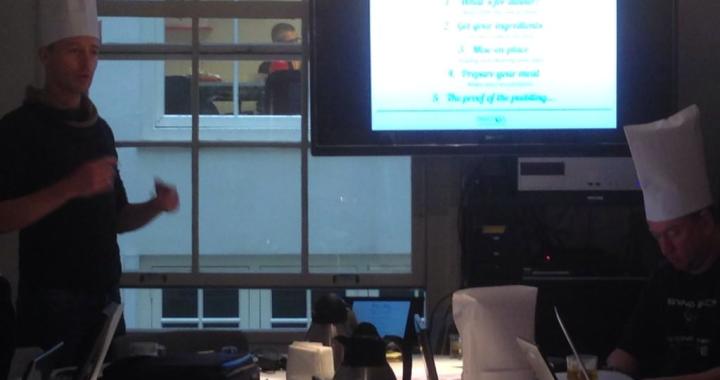Cooking with IATI data¶

Imagine: you’ve produced your first data file using the IATI Standard: your organisation’s activities, partner organisations, budgets and results are neatly represented in an XML file. But before you publish that file, you’d like to show it to your team and colleagues and get feedback. XML will not get them very excited.
That was the premise for our Partos workshop “Using your data”. Data and XML are raw material. You need to clean it, slice and dice it, maybe combine it with other data, and present it.
You need to be cooking with IATI data.
So chef Pelle Aardema and me as sous chef prepared a few recipes to help you understand the steps to take, and get acquainted with the tools you can use.
We also wanted to source locally: recipes made with IATI data of Dutch NGOs.
What’s for dinner?¶
Begin with the end in mind: what is the story you want to tell, or the analysis you want to do? This builds on our previous workshop, looking at publications and reports you currently produce and how IATI data can feed into them. Pick one.
- Spaghetti à la Hivos: a network graph of implementing partners of Hivos in countries where they work.
- Lasagna ICS: a flow diagram of ICS’s budgets going from DAC sectors to countries to implementing partners in those countries.
- Oxfam greens on a bed of World Bank data: a map of Oxfam Novib’s work on poverty reduction in countries, combined with the World Bank’s poverty indicators for those countries.

Spaghetti à la Hivos
Get your ingredients¶
Get and analyse the data: where do you find the IATI XML files you need? Is the data actually suitable for your recipe?
This step included setting up your kitchen: downloading and installing a couple of tools.
- Notepad++ or similar: a text editor to look at raw XML data, for a first glance.
- Editix or similar: a more powerful XML editor, in our case used to transform the XML into an easier to use spreadsheet format.
- Open Refine: the cutting board and knives of any open data chef, to analyse, clean up, filter, slice and dice data.

Lasagna ICS
Mise-en-place¶
Shaping and cleaning your data: mostly using Open Refine. We focused on a few basic skills to get our aspiring chefs started.
- Facets and filtering: looking at the content of columns, maybe fixing small errors, filling in blanks.
- Transformations: replacing text, splitting multi-valued cells.
- Undo, extract and apply: inspecting the steps you’ve taken, rolling back, and re-using the scripts you created.
At the end of this step, you can save the cleaned up data as a new spreadsheet, ready for the next step.

Oxfam greens on a bed of World Bank data
Prepare your meal¶
Make your visualisation: choose a suitable tool, put your cleaned up data into it, and start playing with it until it is clear and useful.
There are many different tools to choose from (we used Google Fusion tables, RAW, and CartoDB), and a lot to learn about proper visualisation. But it all starts with experimenting, trying things out.
The proof of the pudding…¶
It was an exciting experiment to see if we the 16 participants would be able to follow one of our recipes in around two hours. They all managed, in teams of two or three. They kept eachother going with remarkable enthousiasm: unzipping and installing software, playing with XML and JSON code, and juggling with data.
It was the last in our series of four workshops to get NGOs working with IATI:
- Kicking off: what is IATI, how to implement it, who to involve?
- Planning: defining ambitions, policies, goals, timelines.
- Mapping: looking at potential uses of the data, what fields are essential, and where (if at all) are those recorded in current systems?
- Using: once you have an IATI data set, how to work with it?
The focus in the workshops is to build an IATI prototype data set with some information from your own NGO, and to be able to show the benefits of such a data set to your colleagues.
Interested? Partos will run a third series of workshops in early 2015. Or get in touch 🙂
Many thanks to folks at the School of Data and the earlier Open Data Cookbook and Tim Davies for inspiration!
